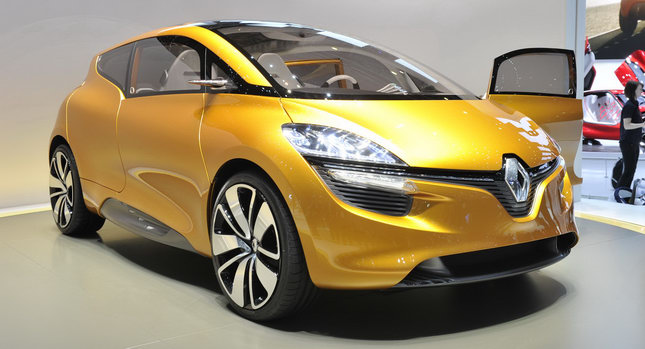Renault is offering us a glimpse of its next generation Scenic with the new R-Space concept model unveiled today at the 2011 Geneva Motor Show. The R-Space is the third concept model after the 2009 DeZir and the Juke-like Captur crossover, which is also on display in Geneva, to showcase the French brand’s new design language conceived by Renault’s chief designer, Laurens van den Acker.
 At 4,250mm meters long, the R-Space is slightly shorter than the current Scenic (4,344mm) and features a much more expressive exterior design. The interior styling is quite futuristic with the floating dashboard and the form of the seats echoing those of the DeZir concept car.
At 4,250mm meters long, the R-Space is slightly shorter than the current Scenic (4,344mm) and features a much more expressive exterior design. The interior styling is quite futuristic with the floating dashboard and the form of the seats echoing those of the DeZir concept car.
“We provided a strong visual and functional contrast between the driver environment, where the focus is on driving pleasure, and a surprising and highly-original rear section conceived as a play space for children,” said interior designer Alexandre Gommier.
One of the highlights of the R-Space is found at the back, where twenty-seven miniature motors power height-adjustable cubes that can take different shapes: an all-flat surface for load carrying, a bench for three passengers, a table or a random configuration that children could create themselves – the last one only when the vehicle is parked.
The MPV concept also previews a new range of fuel-efficient turbocharged gasoline engines as the R-Space is powered by a 900cc three-cylinder petrol engine, which uses turbocharging and direct-injection and is linked to a double-clutch EDC transmission.
This engine, which produces 110 hp and 160 Nm of torque (118 lb-ft), previews the new range of modular TCe engines, called Energy TCe, that Renault will launch in 2012. The R-Space has an average fuel consumption of just 3.7 liters/100 km (63.5 mpg) and CO2 emissions of 95 g/km, thanks to the fitting of an intelligent DRIVINGECO² system, which automatically adapts engine response in relation to the various parameters influencing energy consumption.
The Renault MPV can reach a top speed of 200 km/h (124 mph) and sprints from 0 to 100 km/h in 11 seconds.
By Dan Mihalascu
_______________________________GALLERY_______________________________







































